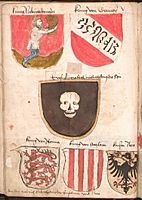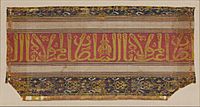Nasrid dynasty facts for kids
| Nasrid dynasty بنو نصر |
|||
|---|---|---|---|
| Country: | Quick facts for kids Emirate of Granada |
||
| Parent House: | Banu Khazraj | ||
| Founder: | Muhammad I of Granada | ||
| Final Ruler: | Muhammad XII of Granada | ||
| Founding Year: | 1230 | ||
The Nasrid dynasty (Arabic: بنو نصر banū Naṣr or banū al-Aḥmar; Spanish: Nazarí) was an Arab dynasty that ruled the Emirate of Granada from 1230 to 1492. It was the last Muslim dynasty in the Iberian Peninsula. Twenty-three emirs ruled Granada from the founding of the dynasty in 1230 by Muhammad I until 2 January 1492, when Muhammad XII surrendered all lands to Queen Isabella I of Castile. Today, the most visible evidence of the Nasrid dynasty is part of the Alhambra palace complex built under their rule.
Contents
Background
The dynasty founded by Muhammad I of Granada held a territory that included Granada, Jaén, Almería, and Málaga. Valencia, Játiva, and Jaén were conquered by Christians during the campaigns of the Reconquista and for the most part, the Nasrids were made into tribute-paying vassals from 1243. Granada continued as a center of Islamic culture. The Nasrids later formed alliances with the Marinids of Morocco.
Nasrid crafts like textile work such as ceramic overglaze used techniques from 9th century Baghdad and were applied to make lusterware, first in Málaga, Murcia, and Almería, and then by the 15th century in Manises. This style of pottery produced first under Muslim patronage, then Christian, influenced the later style of colorful and glazed Italian ceramics known as maiolica. Throughout the 14th century, the Nasrids are noted for their palace architecture like the Alhambra, which was a product of the efforts of Ismail I and Muhammad V.
In 1469, Ferdinand II of Aragon married Isabella I of Castile, uniting the Christian Kingdoms of Castile and Aragon in a common cause dedicated to purging Islam from the Iberian Peninsula. The last Nasrid ruler Muhammad XII of the Emirate of Granada was exiled to Fez (Morocco) in 1492 and the remaining Muslim population was given the status of mudéjar.
-
Coat of Arms of the Emirate of Granada on a wall in the Alhambra, Nasrid dynasty (1013–1492)
Lineage
The Nasrid dynasty was descended from the Arab Banu Khazraj tribe, and claimed direct male-line descent from Sa'd ibn Ubadah, the chief of the tribe and one of the companions of the Islamic prophet Muhammad. The nasab of Yusuf (nicknamed "al-Ahmar", meaning "the Red").
Conflicts of succession and civil war
During the time the Christians were launching a campaign against the Emirate of Granada that would effectively end the Nasrid dynasty, the Nasrids were engaged in a civil war over the throne of Granada. When Abu l-Hasan Ali, Sultan of Granada, was ousted by his son Muhammad XII, Abu l-Hasan Ali retreated to Málaga and civil war broke out between the competing factions. Christians took full advantage of this and continued capturing Muslim strongholds. Muhammed XII was caught by Christian forces in 1483 at Lucena, Córdoba. He was freed after he swore an oath of allegiance to Ferdinand II of Aragon and Isabella I of Castile. Abu l-Hasan Ali finally abdicated in favor of his brother Muhammad XIII, Sultan of Granada, known as Al-Zaghal (the valiant), and a power struggle with Muhammad XII continued. Al-Zaghal prevailed in the inner struggle but was forced to surrender to the Christians. Muhammad XII was given a lordship in the Alpujarras mountains, but instead took financial compensation from the Spanish crown to leave the Iberian Peninsula.
Legacy
The Nasrid dynasty was the longest ruling Muslim dynasty in the Iberian Peninsula, reigning for more than 250 years from the establishment of the Emirate of Granada in 1230 to its annexation in 1492. The Nasrids constructed the Alhambra palace-fortress complex in Granada.
Family tree
The family tree below shows the genealogical relationship between each sultan of the Nasrid dynasty. It starts with their common ancestor, Yusuf al-Ahmar. Daughters are omitted, as are sons whose descendants never reigned. During times of rival claims to the throne, the family tree generally recognizes the sultan who controlled the city of Granada itself and the Alhambra palace.
List of Nasrid sultans of Granada
First dynasty (al-dawla al-ghalibiyya)
Sources::
| S. n. | Name | Birth date | Death date | Reign | Notes |
|---|---|---|---|---|---|
| 1 | Abu Abdallah Muhammad I al-Ghalib bi'llah | c. 1194 | 22 January 1273 | c. 1238 – 22 January 1273 | |
| 2 | Abu Abdallah Muhammad II al-Faqih | c. 1235 | 8 April 1302 | 22 January 1273 – 8 April 1302 | |
| 3 | Abu Abdallah Muhammad III al-Makhlu | 15 August 1257 | 21 January 1314 | 8 April 1302 – 14 March 1309 | |
| 4 | Abu'l-Juyush Nasr | 1 November 1287 | 16 November 1322 | 14 March 1309 – 8 February 1314 |
Second dynasty (al-dawla al-isma'iliyya al-nasriyya)
Sources::
| S. n. | Name | Birth date | Death date | Reign | Notes |
|---|---|---|---|---|---|
| 5 | Abu'l-Walid Ismail I | 3 March 1279 | 8 July 1325 | February 1314 – 8 July 1325 | |
| 6 | Abu Abdallah Muhammad IV | 14 April 1315 | 25 August 1333 | 8 July 1325 – 25 August 1333 | |
| 7 | Abu'l-Hajjaj Yusuf I al-Muayyad bi'llah | 29 June 1318 | 19 October 1354 | August 1333 – 19 October 1354 | |
| 8 | Abu Abdallah Muhammad V al-Ghani bi'llah | 4 January 1339 | 16 January 1391 | October 1354 – August 1359 | |
| 9 | Abu'l-Walid Ismail II | 4 October 1339 | 24 June or 13 July 1360 | 23 August 1359 – 24 June/13 July 1360 | |
| 10 | Abu Abdallah Muhammad VI al-Ghalib bi'llah | 1333 | 25 April 1362 | June/July 1360 – April 1362 | known as "The Red King" (el rey Bermejo) |
| 11 | Abu Abdallah Muhammad V al-Ghani bi'llah (2x) | 4 January 1339 | 16 January 1391 | April 1362 – 16 January 1391 | |
| 12 | Abu'l-Hajjaj Yusuf II al-Mustaghni bi'llah | c. 1356 | 5 October 1392 | 15 January 1391 – 5 October 1392 | |
| 13 | Abu Abdallah Muhammad VII | c. 1370 | 13 May 1408 | 3 October 1392 – 13 May 1408 | |
| 14 | Abu'l-Hajjaj Yusuf III al-Nasir li-Din Allah | 1376 | 9 November 1417 | May 1408 – 9 November 1417 | |
| 15 | Muhammad VIII al-Mutamassik | 1411 | 1431 | November 1417–1419 | known as "the Little One" (al-Saghir/el Pequeño) |
| 16 | Abu Abdallah Muhammad IX al-Ghalib bi'llah | 1396 | 1454 | 1419–1427 | known as "the Left-Handed" (al-Aysar/el Zurdo) |
| 17 | Muhammad VIII al-Mutamassik (2x) | 1411 | 1431 | 1427–1429 | known as "the Little One" (al-Saghir/el Pequeño) |
| 18 | Abu Abdallah Muhammad IX al-Ghalib bi'llah (2x) | 1396 | 1454 | 1430–1431 | known as "the Left-Handed" (al-Aysar/el Zurdo) |
| 19 | Abu'l-Hajjaj Yusuf IV | unknown | 1432 | 1431–1432 | known as Ibn al-Mawl or Abenalmao |
| 20 | Abu Abdallah Muhammad IX al-Ghalib bi'llah (3x) | 1396 | 1454 | 1432–1445 | known as "the Left-Handed" (al-Aysar/el Zurdo) |
| 21 | Abu Abdallah Muhammad X | 1415 | 1454 | 1445 | known as "The Lame" (al-Ahnaf/el Cojo) |
| 22 | Yusuf V | unknown | 1463 | 1445–1446, 1462 | known as Ibn Ismail or Aben Ismael |
| 23 | Abu Abdallah Muhammad X (2x) | 1415 | 1454 | 1446–1447 | known as "The Lame" (al-Ahnaf/el Cojo) |
| 24 | Ismail III | unknown | 1448 | 1447–1448 | |
| 25 | Abu Abdallah Muhammad IX al-Ghalib bi'llah (4x) | 1396 | 1454 | 1448–1453 | known as "the Left-Handed" (al-Aysar/el Zurdo) |
| 26 | Muhammad XI | unknown | 1454 | 1453–1454 | known as "The Little Fellow" (el Chiquito) |
| 27 | Abu Nasr Sa'd al-Mustain bi'llah | unknown | 1465 | 1454–1462 | known as Ciriza and Muley Zad |
| 28 | Ismail IV | unknown | 1463 | 1462–1463 | |
| 29 | Abu Nasr Sa'd al-Mustain bi'llah (2x) | unknown | 1465 | 1463–1464 | known as Ciriza and Muley Zad |
| 30 | Abu'l-Hasan Ali | unknown | 1485 | 1464–1482 | known as Muley Hacén |
| 31 | Abu Abdallah Muhammad XII | c. 1460 | 1533 | 1482 | known as Boabdil |
| 32 | Abu'l-Hasan Ali (2x) | unknown | 1485 | 1482–1485 | known as Muley Hacén |
| 33 | Abu Abdallah Muhammad XIII | c. 1444 | c. 1494 | 1485–1486 | known as "The Brave" (al-Zaghal/el Zagal) |
| 34 | Abu Abdallah Muhammad XII (2x) | c. 1460 | 1533 | 1486–1492 | known as Boabdil |
See also
 In Spanish: Nazarí para niños
In Spanish: Nazarí para niños






